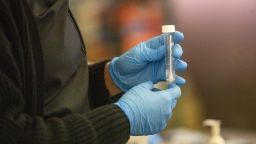The US Centers for Disease Control and Prevention is expected to shift its Covid-19 isolation guidance this spring to say that people no longer need to isolate once they have been fever-free for 24 hours and their symptoms are mild or improving, according to the Washington Post.
The Post cited four unnamed agency officials and said the planned shift was discussed internally last week and in a briefing with state health officials.
The CDC said there were no changes to the agency’s isolation guidelines to announce “at this time.”
“We will continue to make decisions based on the best evidence and science to keep communities healthy and safe,” said Dave Daigle, a spokesperson for the CDC.
Since 2021, the agency has said people should isolate for at least five days if they tested positive for Covid-19, and then continue to mask. The updated guidance would bring Covid-19 in line with guidance for other respiratory viruses, such as flu.
CNN previously reported that California and Oregon had recently broken with CDC’s guidance to say that people who test positive for Covid-19 are no longer expected to isolate for a set period of time — and those without symptoms don’t have to isolate at all.
The science around Covid-19 transmission hasn’t changed, but experts broadly agreed after the California and Oregon changes that easing isolation timeframes won’t significantly increase community transmission or severe outcomes, in part because the virus has been circulating at very high levels, even with more restrictive guidance in place.
Some infectious disease experts said the change made sense because it would align with what many Americans already do.
Dr. William Schaffner, an infectious disease expert at Vanderbilt University, cited the latest coronavirus variant, JN.1, as a case in point.
“It’s producing a lot of mild infection. Lots of people are not even testing,” he said.
If they test positive, people aren’t really following strict guidelines for isolation anymore.
“Once they feel better, they’re going back to their normal activities. They are not rigorously putting themselves in isolation for five days,” Schaffner said.
Other experts also agreed that the update was prudent.
“Given the increased amount of immunity to Covid-19 in the population, access to treatment for Covid-19 and reductions in hospitalizations and deaths, it seems reasonable for the CDC to adapt our national strategies,” said Dr. Clay Marsh, West Virginia’s Covid-19 czar.
“Currently, many of our citizens are no longer testing for Covid-19 and are not actively isolating,” Marsh said. “With the caveat of the risk of long Covid and the potential for mortality in the elderly and immunocompromised, the future guidance by CDC meets the standard we are seeing.”
Not everyone thinks the possible change is a good idea, however, noting that it would just greenlight more transmission of the infection.
Get CNN Health's weekly newsletter
Sign up here to get The Results Are In with Dr. Sanjay Gupta every Tuesday from the CNN Health team.
“This is a reckless policy change that will only serve to promote more spread of Covid and Long Covid,” Dr. Eric Topol, founder and director of the Scripps Research Translational Institute, said in an email. Topol co-authored one of the first reviews of asymptomatic Covid-19 infections.
Wastewater surveillance data published by the CDC suggests that Covid-19 is still circulating at high levels across the US, but the agency notes that “infections are causing severe disease less frequently than earlier in the pandemic.”
Still, tens of thousands of people are hospitalized with Covid-19 and hundreds of people die from the virus each week. There were about 21,000 Covid-19 hospitalizations during the week ending February 3, according to the latest CDC data. That’s about 20% lower than this time last year but more than three times more than the low point from this summer.
CNN’s Deidre McPhillips and Meg Tirrell contributed to this report.



















